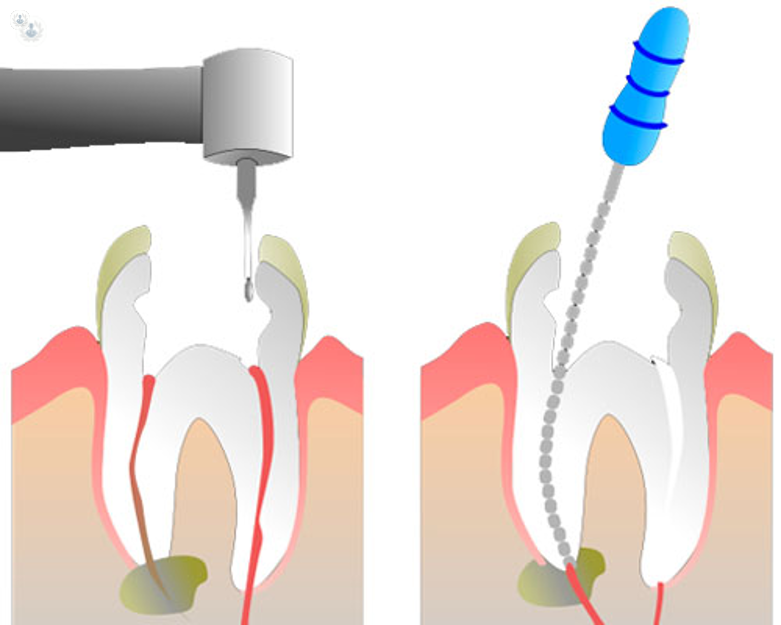How do you spell relief? Well, if you’ve ever had a major infection that’s reached the roots of your tooth, relief probably meant R-O-O-T-C-A-N-A-L. A root canal can help get you out of pain and can prevent the need for a tooth extraction. For the most part, root canals are successful — and your dental treatment may last a lifetime. But for the five percent of root canals that don’t heal, endodontic retreatment is often necessary to save the tooth.
What’s the Point?
Endodontic therapy is a complicated procedure that uses files to extract infected pulp from the root. When the infection remains in the root’s canals, the tooth may not heal, causing it to become reinfected. There are several ways this can happen:
- Newly formed tooth decay can cause a leakage of bacteria into the root canal.
- The dental crown used to protect the tooth cracks, breaks or is placed too late, allowing new infection to enter the root.
- The roots weren’t cleaned thoroughly or where missed completely — it can be difficult to remove the infection in curved root canals and some of the canals may be too hard to see, causing them to remain untreated.
- The roots were incorrectly sealed or filled.
- The tooth was contaminated by saliva during the procedure.
That’s How You Know
Many dental patients experience some discomfort as their tooth heals following a dental procedure — so how will you know if your root canal requires endodontic retreatment?
Discomfort that does not go away within a couple of days or an increase in pain could be signs that your root canal is reinfected. If the toothache remedies prescribed by your dentist don’t give you any relief, it may be also be a sign of a problem.
You may not experience symptoms right away — a failed root canal can happen months or even years after the original procedure is performed. If the infection travels to the bone, a dental abscess can form, causing swelling in the gums.
Your dentist will take an X-ray of your tooth to diagnose any dental problems and determine whether you need endodontic retreatment.
Here We Go Again
While your dentist may be able to retreat the tooth, endodontic retreatment is usually performed by endodontists, or root canal specialists. The first step in endodontic retreatment is non-surgical retreatment, which is performed much like a typical root canal. Your dentist needs to gain access to the roots by either removing the dental crown or drilling directly through the crown itself. The dental crown’s post, which is embedded into the tooth to keep it in place, will need to be removed. Once the tooth filling material is extracted, files are used to reshape the root’s canals, which are then cleaned and filled with gutta percha. Once your endodontic retreatment is complete, your dental crown will be filled or you will be fitted for a new one.
Although the procedure is similar to your original root canal treatment, it requires more precision to better remove what was missed before. A Dental Operating Microscope is extremely beneficial during endodontic retreatment procedures — it magnifies the area to help your dentist locate the canals and signs of infection. But even with high-tech equipment, non-surgical retreatment may require more time and several dental visits to complete.
The Final Chapter
In some cases, your dentist may not be able to remove all of the infection during endodontic retreatment. Your dentist may skip nonsurgical endodontic retreatment altogether if the post that holds your crown in place can’t be removed or if the canals are too narrow, blocked or curved to gain access to them. If endodontic retreatment doesn’t work or isn’t an option, endodontic dental surgery may be required.
Endodontic surgery requires a small incision to be made in your gums. After your dentist cleans out any infection found around the tooth, he or she will shave off 3 to 4 millimeters of the root and clean the inside of the canal from the root’s tip. The root is then filled and the gums are stitched to complete the procedure. This type of endodontic surgery is often referred to as an apicoectomy. Your dentist may also choose to perform a root resection, where an entire root is removed from your tooth.
Dentists may use both nonsurgical retreatment and endodontic surgery to fix your root canal. If none of these treatments are successful, the only option is a tooth extraction. If you’re experiencing discomfort in a tooth that had a root canal, don’t ignore it. The sooner you have endodontic retreatment, the better chance you’ll have of saving your tooth — and getting relief from your pain!

